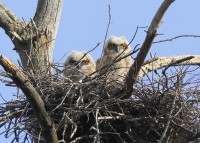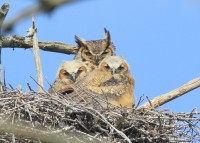Great Horned Owl and owlets!
April 26, 2018 in Great Horned Owl
 Under clear blue skies and beautiful late day sun, winds form W at 13MPH and gusting up to 25MPH, had nice looks at female Great Horned Owl and two owlets. They were keeping a close eye on a nearby Raven that was making loud threat vocalizations and strafing the nest but from a distance. It caught the full attention of the female, and whatever the female watches, the owlets pay close attention. Only when an owl nest is left unattended or an adult is driven from the nest by human activity is there predation on eggs and nestlings by crows or ravens.
Under clear blue skies and beautiful late day sun, winds form W at 13MPH and gusting up to 25MPH, had nice looks at female Great Horned Owl and two owlets. They were keeping a close eye on a nearby Raven that was making loud threat vocalizations and strafing the nest but from a distance. It caught the full attention of the female, and whatever the female watches, the owlets pay close attention. Only when an owl nest is left unattended or an adult is driven from the nest by human activity is there predation on eggs and nestlings by crows or ravens.
 Here is a quick framework of growth and development. Owlets exhibit hostile behavior at approach of nearby intruders by 15 days: hisses and sways from side to side, claps bill and raises wing stubs. By 19 days, capable of exaggerated head movements while observing objects. Curiosity fully evident by 21 d; grasps objects in nest with toes and nibbles them. Able to feed self by 20-27 days (although female may continue to feed nestlings through 5th wk). Drops pellets after third week, and defecates in nest until about fourth week; thereafter attempts to eliminate over edge of nest. Able to climb well by 40 days, at which time young may leave the nest and clamber out along a tree branch or along a ledge. Young fully feathered and capable of flight by 45-49 d.
Here is a quick framework of growth and development. Owlets exhibit hostile behavior at approach of nearby intruders by 15 days: hisses and sways from side to side, claps bill and raises wing stubs. By 19 days, capable of exaggerated head movements while observing objects. Curiosity fully evident by 21 d; grasps objects in nest with toes and nibbles them. Able to feed self by 20-27 days (although female may continue to feed nestlings through 5th wk). Drops pellets after third week, and defecates in nest until about fourth week; thereafter attempts to eliminate over edge of nest. Able to climb well by 40 days, at which time young may leave the nest and clamber out along a tree branch or along a ledge. Young fully feathered and capable of flight by 45-49 d.
Literature cited:
Artuso, C., C. S. Houston, D. G. Smith, and C. Rohner (2013). Great Horned Owl (Bubo virginianus), version 2.0. In The Birds of North America (A. F. Poole, Editor). Cornell Lab of Ornithology, Ithaca, NY, USA. https://doi.org/10.2173/bna.372









